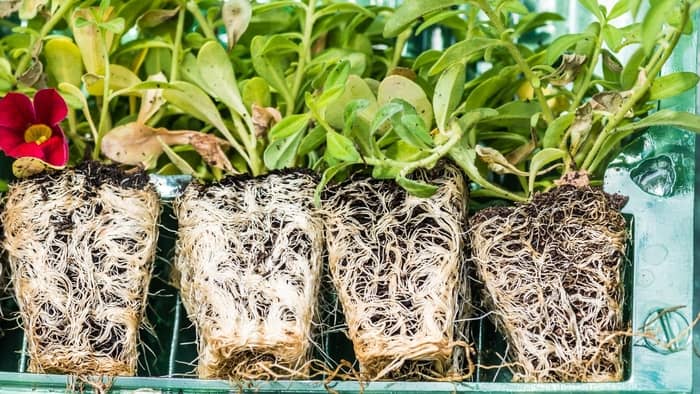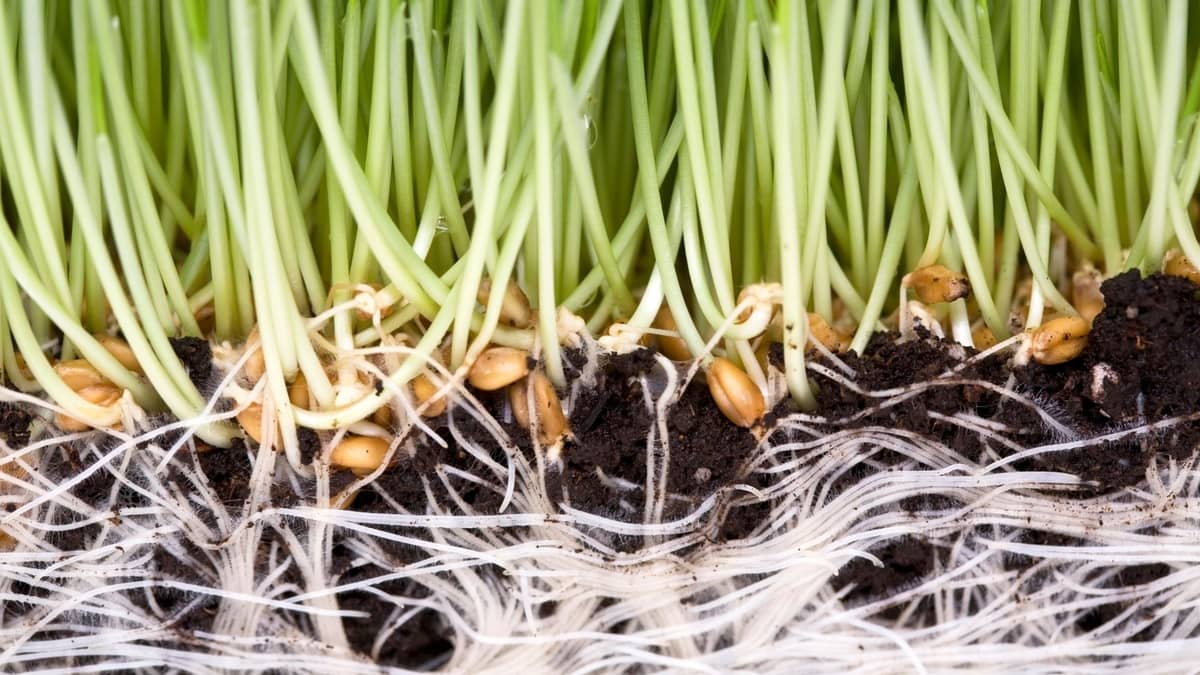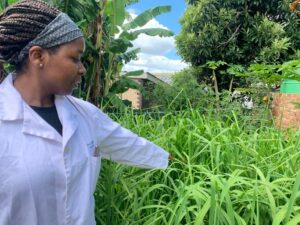Last Updated on December 28, 2022 by Griselda M.

First Of All, What is a Root?
Ok, before we delve into the types of roots, let us define what a root is. A root is an underground structure in vascular plants. It helps to anchor the plant in the ground.
The root functions to absorb salts and water and transport these to the stem and leaves where they can be used by the plant. Sugars from these areas are returned to the roots to keep them fed. In some cases, roots can be adapted to store surplus water and nutrients.
What are the main types of roots?
There are three main types of root systems.
1) Taproots
These are typical of dicotyledonous (plants where the seeds have two halves, that form two first leaves) and gymnosperms (plants like pine trees) and consist of a dominant main root that grows downwards with lateral roots branching off from this.
2) Fibrous roots
The focus of our article – is found in monocotyledonous plants (plants where the seed has one piece and one first leaf). These roots emanate from a central point and are roughly equal in length.
3) Adventitious roots
These are roots that arise from an organ other than a root – and develop into roots. As an example, if we take a stem/leaf cutting and plant it, the roots that develop are adventitious. If you take a cutting of a plant that had a taproot and root this cutting, it will have a fibrous root system even though the parent had a tap root. This is because adventitious roots grow outwards as do fibrous roots.

Plants With Fibrous Roots
Many of our favorite food plants have fibrous roots. Let us look at a few fun examples!
-
Onions
Onions have tiny roots but numerous ones. Many people will tell you that onions have shallow roots – if your soil is healthy, onions will penetrate up to 30 inches into the soil! This is why they can concentrate so many healthy minerals into the onion for us to enjoy.
-
Asparagus
Asparagus is a monocotyledonous plant and consequently has fibrous roots. However, it has storage roots that can give rise to adventitious roots – that in turn have a fibrous nature.
-
Maize/corn
This is probably my favorite fibrous-rooted plant! Being a monocotyledon, maize is a textbook example of a plant with fibrous roots! Just to be a little bit irritating, maize also has adventitious roots.
-
Dwarf bamboo
Dwarf bamboo has small fibrous roots that help it to grow through thick soil.
-
Garlic
Garlic is shallow-rooted and grows in a clump with the root system on the outside. Being a monocotyledonous plant, it has fibrous roots by default.
-
Pumpkins
These are dicotyledonous plants, hence they have a central tap root – as they grow, however, the stems form adventitious roots that root and grow in a fibrous style. In this regard, this plant displays both types of root systems, but in my experience, until it puts down fibrous roots, the pumpkin is nothing more than a one-pumpkin wonder! Let it sprawl and 90% of its roots are fibrous and you get a twenty-pumpkin family feeder.
-
Sugarcane
Sugarcane is a shallow-rooted plant with a fibrous root system. It is a monocotyledonous plant, so this is to be expected.
-
Sorghum
Sorghum is a shallow-rooted monocotyledonous plant. I love growing sorghum and harvesting the seeds for my chickens. It can be a perennial plant if you get mild winters. I have a few clumps that are five years old now.
-
Switchgrass
Switchgrass is a perennial with a deep taproot. It’s used primarily for hay production. It’s commonly grown in a deep mound. The root system is strong and durable. Switchgrass is sensitive to drought and will produce less when moisture is limited.
-
Rice
Rice is a monocotyledonous plant that grows well in a watery environment. I and Dr. Nyiko who also writes on this site have had a lot of fun growing rice in our garden. It produces an extreme network of fibrous roots in the paddy.
-
Leeks
Closely related to Onions, leaks are also monocots and have a fibrous root system. I cannot find a reference to exactly how deep leek roots go, but I would hazard a guess that they go far deeper than onion roots. Leeks are a must-grow in any garden!
-
Wheat, barley, oats, rye
If it were not for these plants a lot of us would not be here! They account for a significant percentage of the total food intake of humanity, and as humble monocotyledonous plants with a simple fibrous root system, these plants are indispensable to modern humanity.
Dr. Nyiko, who also writes on this blog shows off her Kilombero rice that she uses to clean water in our experimental rice paddy at Camdini. Rice has a fibrous root system.
Noot Organic Indoor Plant Soilless Potting Mix Coconut Coir
Is Radish a Taproot or Fibrous Root?
Radish is by definition a tap root. It is also a tuber as it stores nutrients and water in the root. Read these articles if you want to find out more about the genetics and evolutionary adaptations this root has undergone and the health benefits it confers.
Seeing as you asked this question I must also encourage you to grow radishes! This is one of the most rewarding crops to grow, because it is super quick from seed to table, and a thing many people do not know is that the leaves are an amazing superfood! So not only can you eat the radish taproots with all their stored nutrients and phytomedicinal compounds, you can eat the leaves. There is a lot of research looking at how the compounds in radish leaves can save lives.
Is a Carrot a Taproot or a Fibrous Root?
A carrot is the quintessential tuberous taproot. The long thickened root is a rich store of water and nutrients that is a joy to grow.
If you decide to grow carrots, try and grow the weird color varieties! When you harvest your taproots – erm sorry – carrots – you will get great joy out of these unusual colors. Even if they promise that the seed is all purple carrots, you will get a few oranges in there every time too. Is a potato a taproot or a fibrous root?
Potato is in fact a stem tuber. This means that the part of the plant we eat is an underground thickened storage stem. If you plant a seed potato tuber, it will produce fibrous roots as it has not germinated from a seed.
If you plant a potato seed (they form in potato cherries above the ground) it will produce a tap root, and on this tap root, little tubers will grow. If you plant these tubers again, they will produce fibrous roots.
Is Mango a Taproot or a Fibrous Root?
When a mango seed germinates, it produces a strong tap root that penetrates deep into the soil. In many cases, this tap root will eventually die and the plant’s fibrous root system becomes dominant. Often when you buy a mango tree it is actually based on a grafted plant and will have a fibrous root system. If you grow a mango from seed, it starts with a tap root.
Is Beetroot a Taproot or a Fibrous Root?
Beetroot is a tap root plant, that forms a tap root tuber. It stores nutrients in the root tuber. Unlike the carrot, this tuber is quite flat and round and can form on the surface of the soil, rather than below the soil in the case of carrots.
Does Aloe Vera Have Tap Roots or Fibrous Roots?
All aloes are monocotyledonous plants. This means that by definition they have fibrous roots. Dicotyledonous plants produce tap roots. Aloes are monocotyledonous, and in many cases, such as Aloe vera, we do not even grow them from seed – rather from cuttings.
Is Okra a Fibrous Root?
Okra, or Abelmoschus esculentus, is a dicotyledonous plant and produces a tap root upon germination. I have grown Okra for about 25 years, and have recently found that growing it from cuttings is a good option. When you do this, the cuttings produce a fibrous root system.
Final Thoughts
The above list of plants with fibrous roots is not fully exhaustive. We have hundreds of thousands of plants with fibrous roots across the world. Some of them are used as food; some are just for ornamental beauty, and the vast majority provide ecosystem services to keep the planet alive.
All of them are brought together to make the world a better place! I enjoy eating things, so I focussed on edible ones that are fun to grow!
Read more about Money Plant Sunlight Needs – A Closer Look.
Frequently Asked Questions
What does fibrous root mean?
Fibrous roots radiate from a central point and are typically similar in length. The differ from tap roots that are long with smaller roots that branch off.
Where do plants with fibrous roots grow commonly?
Pretty much all over Earth. Grasses have fibrous roots and they are everywhere. Many other plants with fibrous roots, such as palms, asparagus and onions are grown all over the planet.
What is the main functions of fibrous roots?
Roots anchor plants, absorb water and nutrients and can in some cases store water and nutrients. Fibrous roots perform all of the above functions in the various forms they take.
Caroline is a gardener who loves to get down to the nitty–gritty of gardening. She proudly proclaims herself as a ‘dirt worshipper‘ and can often be found deep in the garden, covered in soil and singing to her plants. As a self–proclaimed ‘plant whisperer‘, Caroline believes that plants need love and attention just like any other living thing, and she loves to give them both. When she‘s not tending to her garden, you can often find her researching the latest gardening trends, or teaching others how to make their gardens thrive




